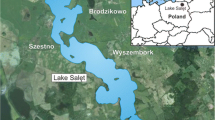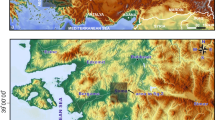Abstract
A 7.5 m sediment core from Lake Bolata, a small former coastal liman lake in northeastern Bulgaria, was analyzed for pollen and plant macrofossil content in attempt to trace the changes in the vegetation, human impact and the influence of the Black Sea during the last ca. 6,000 years. Lake Bolata started its existence when the rising Black Sea level reached the elevation of the bottom of the depression. By that time nearly all tree species were already present in this area with the exception of Carpinus orientalis. The comparison of the arrival time of oriental hornbeam at different sites along the Bulgarian Black Sea confirmed the reliability of the local radiocarbon chronology. For the period under study the vegetation of the region around the site can be described as a forest-steppe due to NAP values higher than 40% of the pollen sum. Forests on the slopes of the river canyon consisted of Quercus spp., Acer, Carpinus orientalis, Fraxinus ornus, Fagus and possibly Tilia. Riverine forests formed stands composed of Salix, Alnus, Ulmus, Fraxinus, Carpinus betulus and Vitis as a liana. The vegetation on the Cape Kaliakra plateau, bordering the canyon, was dominated by diverse herbs and most of these could be considered xerophytes. The oldest occupation period belongs to the Eneolithic, documented by the occurrences of Triticum-type pollen at 5570–5170 cal b.p. (3620–3220 b.c.). The next period of higher continuous Cerealia-type values corresponds to 3450–1830 cal b.p. (1500 b.c.–a.d. 120). The macrofossil record chiefly provides evidence about plant communities of aquatics and helophytes.






Similar content being viewed by others
References
Aalto M (1970) Potamogetonaceae fruits. I. Recent and subfossil endocarps of the Fennoscandian species. Acta Bot Fenn 88:1–85
Atanassova J (1995) Palynological data of three deep water cores from the western part of the Black Sea. In: Bozilova E, Tonkov S (eds) Advances in Holocene palaeoecology in Bulgaria. Pensoft, Sofia-Moscow, pp 68–83
Atanassova J (2005) Palaeoecological setting of the western Black Sea area during the last 15 000 years. Holocene 15:576–584
Atanassova J, Tonkov S, Bozilova E, Filipova M (2002) Palynological investigation of Holocene sediments from Lake Burgas. Ann Univ Sofia Fac Biol (Bot) 92:127–138
Bondev I (1991) The vegetation of Bulgaria. Map 1:600 000 with explanatory text (In Bulgarian with English summary). St. Kliment Ohridski University Press, Sofia
Bondev I (2002) Geobotanic regioning. In: Kopralev I (ed) Geography of Bulgaria. ForCom Publ, Sofia, pp 336–351 (in Bulgarian)
Bozilova E, Beug HJ (1992) On the Holocene history of vegetation in SE Bulgaria (Lake Arkutino, Ropotamo region). Veget Hist Archaeobot 1:19–32
Bozilova E, Beug HJ (1994) Studies on the vegetation history of Lake Varna region, northern Black Sea coastal area of Bulgaria. Veget Hist Archaeobot 3:143–154
Bozilova E, Ivanov I (1985) Paleoenvironment in the area of the Varna Lake during Eneolithic and Bronze Age on the basis of palynological, paleoethnobotanical and archaeological evidence. Bull Musee Nat Varna 21:43–78 (in Bulgarian)
Bozilova E, Tonkov S (1985) Palaeoecological studies in Lake Durankulak. Ann Univ Sofia Fac Biol (Bot) 76:25–30
Bozilova E, Filipova M (1986) Palaeoecological environment in NE Black Sea area during Neolithic, Eneolithic and Bronze Periods. Studia Praehist 88:160–166
Bozilova E, Tonkov S (1998) Towards the vegetation and settlement history of the southern Dobrudza coastal region, north-eastern Bulgaria: a pollen diagram from Lake Durankulak. Veget Hist Archaeobot 7:141–148
Bozilova E, Tonkov S (2002) Paleoecological evidence on the vegetation history and human occupation in the coastal area of Lake Durankulak, Northeastern Bulgaria. In: Todorova H (ed) Durankulak, Band II. Die prähistorischen Graberfelder. DAI, Berlin, pp 309–312 Teil 1
Bozilova E, Atanassova J, Filipova-Marinova M (1997) Marinopalynological and archaeological evidence for the lateglacial and Holocene vegetation in Eastern Bulgaria. Ann Univ Sofia Fac Biol (Bot) 89:69–81
Chepalyga A (1984) Inland sea basins. In: Velichko A, Wright HE, Barnosky CW (eds) Late Quaternary environment of the Soviet Union. Longman, London, pp 229–247
Chepalyga A (2002) Black Sea. In: Velichko A (ed) Dynamics of terrestrial landscape components and inner marine basins of northern Eurasia during the last 130000 years. GEOS, Moscow, pp 170–182 (in Russian)
Delipavlov D, Dimitrov D, Guteva Y, Jancheva H (1997) Flora and vegetation in the Reserve Kaliakra and the adjacent territories. Dobrudzha and Kaliakra. Collection of papers. Acad Publ House Agricultural University, Plovdiv, pp 27–35 (in Bulgarian)
Dimitrov D (1979) Climatology of Bulgaria. Nauka i Izkusstvo, Sofia (In Bulgarian)
Dimov T (2002) Archaeological finds of culture Hamangia along the Lower Danube and the Western Black Sea coast. Sci Rep Dobrich 4:141–155 (in Bulgarian)
Dimov T (2003a) Topography, stratigraphy and architecture of the settlements from the prehistoric culture Hamangia in Dobrudza. Dobrudza 21:123–143
Dimov T (2003b) Neolithic and copper age sites in the Northeast Balkans (with special reference to Hamangia culture). In: Nikolova L (ed) Early symbolic systems for communication in Southeast Europe. BAR Intern Series 1139, Oxford, pp 459–467
Dzingov G (1990) Kaliakra, vol 1. Sofia (in Bulgarian)
Filipova M (1985) Palaeoecological investigations of Lake Shabla-Ezeretz in NE Bulgaria. Ecol Mediterr 11:147–158
Filipova M, Bozilova E, Tonkov S (1993) Palynology of submerged archaeological sites along the Bulgarian Black Sea coast. PACT 47:43–51
Filipova-Marinova M (2003a) Postglacial vegetation dynamics in the coastal part of the Strandza Mountains, Southeastern Bulgaria. In: Tonkov S (ed) Aspects of palynology and palaeoecology. Pensoft, Sofia-Moscow, pp 213–232
Filipova-Marinova M (2003b) Paleoenvironmental changes along the Southern Black Sea Coast of Bulgaria during the last 29000 years. Phytol Balcanica 9:275–292
Filipova-Marinova M (2006) Palynological data for the vegetation dynamics and climate changes along the Bulgarian Black Sea coast during the Quaternary. DSc Thesis. Sofia (in Bulgarian)
Filipova-Marinova M, Bozilova E (1990) Palaeoecological investigation of Lake Shabla-Ezeretz on the Bulgarian Black Sea coast. In: Krastev T (ed) Geological evolution of the western part of the Black Sea in Neogen-Quaternary. Publishing House Bulg Acad Sci, Sofia, pp 41–87 (in Russian)
Filipova-Marinova M, Bozilova E (2002) Palaeoecological conditions in the area of the praehistorical settlement in the bay of Sozopol during the Eneolithic. Phytol Balcanica 8:133–143
Grimm E (2004) TGView (version 2.0.2). Illinois State Museum, Springfield, USA
Horvat L, Glavac V, Ellenberg H (1974) Vegetation Südosteuropas. Fischer, Stuttgart
Ivanov I (1973) The prehistoric pile settlement Strashimirovo 2. Bull Musee National Varna 9:285–288 (in Bulgarian)
Katz NJ, Katz SV, Kipiani MG (1965) Atlas and keys of fruits and seed occurring in the Quaternary deposits of the USSR. NAUKA, Moscow (in Russian)
Kozuharov S, Dimitrov D, Lazarova M, Kozuharova E (1997) Characteristics of flora and vegetation of the natural plant complexes in South Dobrudzha. Dobrudzha and Kaliakra. Collection of papers. Acad Publ House Agricultural University, Plovdiv, pp 42–58 (in Bulgarian)
Krebs P, Conedera M, Pradella M, Torriani D, Felber M, Tinner W (2004) Quaternary refugia of the sweet chestnut (Castanea sativa Mill.): an extended palynological approach. Veget Hist Archaeobot 13:145–160
Marinova E (2003) The new pollen core Lake Durankulak-3: a contribution to the vegetation history and human impact in Northeastern Bulgaria. In: Tonkov S (ed) Aspects of palynology and palaeoecology. Pensoft, Sofia-Moscow, pp 257–268
Marinova E, Atanassova J (2006) Anthropogenic impact on vegetation and environment during the Bronze Age in the area of Lake Durankulak, NE Bulgaria: Pollen, microscopic charcoal, non-pollen palynomorphs and plant macrofossils. Rev Palaeobot Palynol 141:165–178
Ninov N (1997) The soils in the Kaliakra area and its surroundings. Dobrudzha and Kaliakra. Collection of papers. Acad Publ House Agricultural University, Plovdiv, pp 21–26 (in Bulgarian)
Peev P (2009) The Neolithisation of the Eastern Balkan Peninsula and fluctuations of the Black Sea level. Quat Int 197:87–92
Popov N, Mishev K (1974) Geomorphology of the Bulgarian Black Sea coast and shelf. Bulg Acad Sci, Sofia
Rabien I (1953) Zur Bestimmung fossiler Knospenschuppen. Paläont Z 27:57–66
Shopov V, Bozilova E, Atanassova J (1992) Biostratigraphy and radiocarbon data of Upper Quaternary sediments from western part of the Black Sea (In Bulgarian with English summary). Geol Balcanica 22:59–69
Todorova H (1984) Dobrudza in prehistory. In: Fol A, Dimitrov S (eds) History of Dobrudza. Bulg Acad Sci, Sofia, pp 23–45 (in Bulgarian)
Todorova H (1986) The Eneolithic in Bulgaria (5th millenium BC). Nauka i Iskustvo, Sofia (in Bulgarian)
Todorova H (1995) The Neolithic, Eneolithic and Transitional period in Bulgarian prehistoruy. In: Bailey DW, Panayotov I (eds) Prehistoric Bulgaria. Prehistory Press, Madison, pp 79–98
Todorova H (ed) (2002) Durankulak. Band II. Die praehistorishe Graberfelder, vol 1. Publ House Anubis, Berlin-Sofia
Tschakalova E, Bozilova E (1986) Subfossil material from the Early Bronze Age. Ann Univ Sofia (Bot) 74:19–27
Velchev V (2002) Types of vegetation. In: Kopralev I (ed) Geography of Bulgaria. ForCom Publ, Sofia, pp 324–335 (in Bulgarian)
Weninger B, Jöris O, Danzeglocke U (2009) CalPal-2007. Cologne Radiocarbon Calibration & Palaeoclimate Research Package. http://www.calpal.de/
Yanko-Hombach V, Gilbert A, Dolukhanov P (2007) Controversy over the great flood hypotheses in the Black Sea in light of geological, paleontological, and archaeological evidence. Quat Int 167–168:91–113
Acknowledgements
The study area was visited several times for field work and the authors are thankful to Mr. Parvan Markov for his help during these trips. The late Prof. Stefan Kozuharov, Botanical Institute Sofia, provided useful information on the recent floristic composition. Dr. Anna Ganeva, Botanical Institute Sofia, kindly performed the identification of the moss remains. Dr. Anita Tosheva helped with the drawing of Fig. 1. The Editor-in-Chief and both anonymous reviewers provided useful comments and suggestions to improve the manuscript. Dr. John Daniell corrected the English of the text.
Author information
Authors and Affiliations
Corresponding author
Additional information
Communicated by F. Bittmann.
Rights and permissions
About this article
Cite this article
Tonkov, S., Beug, HJ., Bozilova, E. et al. Palaeoecological studies at the Kaliakra area, northeastern Bulgarian Black Sea coast: 6000 years of natural and anthropogenic change. Veget Hist Archaeobot 20, 29–40 (2011). https://doi.org/10.1007/s00334-010-0244-4
Received:
Accepted:
Published:
Issue Date:
DOI: https://doi.org/10.1007/s00334-010-0244-4




